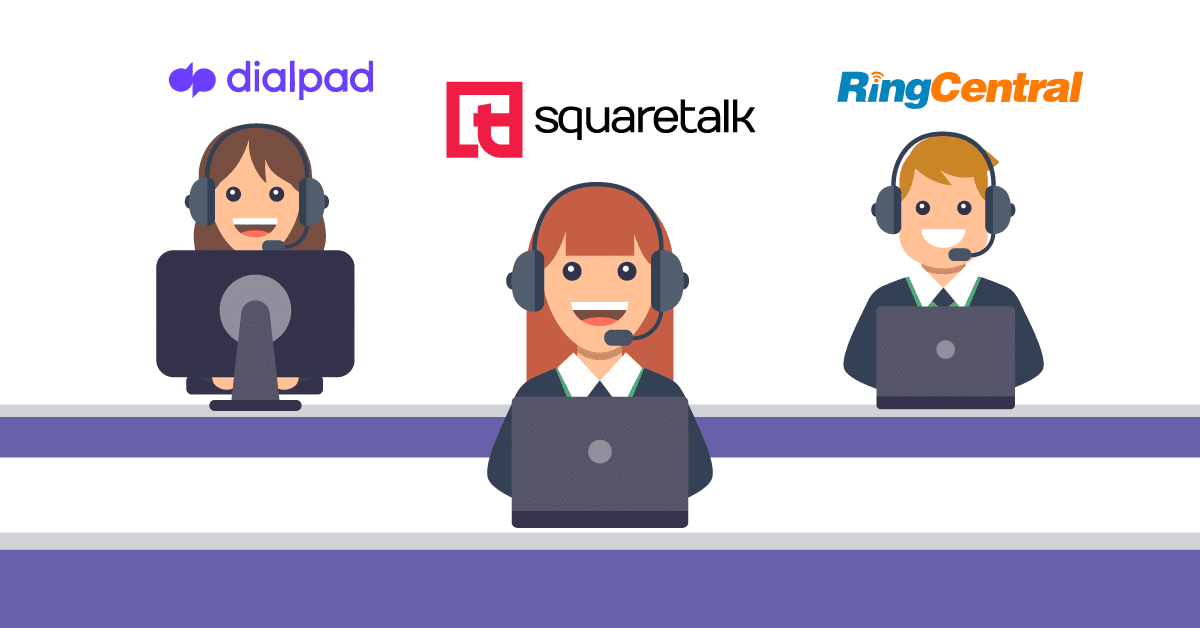Unpredictable call volumes, staffing challenges, and the constant battle to maintain high service levels – managing a call center workforce can be overwhelming.
At Squaretalk, we understand that simply assigning agents to shifts and expecting consistent results won’t cut it. You need to balance operational efficiency, employee satisfaction, and customer delight.
But how do you keep your teams flexible, motivated, and productive?
The answer often is call center workforce management (WFM).
In this guide, we’ll walk you through everything you need to know about WFM starting with what it is and why it’s vital for your call center success. Then, we’ll explore its key features, benefits, challenges, and proven best practices.
Let’s dive in!
What is Workforce Management and Its Role in a Call Center?
Workforce management in a call center involves an integrated set of procedures to optimize agent performance while enhancing operational efficiency. Companies using WFM software report a 25% improvement in employee productivity.
WFM ensures:
- The necessary number of agents with certain skill sets are scheduled to meet your call center objectives.
- Workloads are evenly distributed.
- Costs are minimized without sacrificing customer experience.
Effective WFM ensures service levels are met while balancing costs and agent productivity.
The Workforce Management Cycle
The Workforce Management Cycle is a continuous process, which is integral for driving data-driven improvements to both customer experience and operational performance.
It ensures that staff levels match call volumes and business needs while balancing efficiency and agent experience.
The Workforce Management Cycle consists of :
1. Forecasting : Analyzing historical data, trends, and future campaigns to predict call volumes. This helps you determine how many agents are needed to maintain service levels and coordinate full-time, part-time, and remote/hybrid employees if you have them.
2. Scheduling : Creating schedules that align with forecasted demand and agent preferences. This helps you balance efficiency and employee satisfaction.
3. Managing : Monitoring service levels in real time. This allows you to adjust schedules as needed (e.g., reassign team members, offer overtime, or release agents early).
4. Performance Analysis and Continuous Improvement : Assessing WFM metrics to identify trends, bottlenecks, and inefficiencies. This step ensures alignment between business goals and workforce execution, driving data-driven optimizations for future scheduling.
Workforce Management Features in Call Centers
Workforce management in call centers is supported by various features that ensure smooth operations and high-quality customer service.
1. Real-Time Dashboards
Most CCaaS platforms focus on operational and service-level metrics that can share light into your WFT effectiveness, like :
- Call Volumes
- Call Abandonment Rate
Specific WFM dashboards provide additional live insights into agent activities. Managers can monitor :
- Forecast Accuracy
- Agent Turnover and Attrition
Using the data from real-time monitoring managers can redeploy agents swiftly when demand spikes unexpectedly, ensuring service levels remain consistent.
Squaretalk Tip : Use performance data from both WFM-specific and standard CCaaS dashboards to assess agent knowledge gaps, form teams based on skill sets, and identify trends.
2. Real-Time Adherence Monitoring Features
Schedule adherence is crucial for maintaining efficiency in a hectic call center environment. WFM features help :
- Compare agents’ actual status to their scheduled shifts.
- Identify deviations, like late logins, extended breaks, or early logouts.
- Sent alerts and notifications to supervisors when adherence issues arise.
3. Staff Forecasting and Scheduling Tools
Accurate forecasting and scheduling hinge on historical data. Based on it, predictive analytics can determine how many agents are needed for peak and slower periods. Many CCaaS platforms use AI and Machine Learning to dynamically adjust forecasts based on unexpected events, call volume spikes, or external factors.
Importance of Call Center Workforce Management
The significance of workforce management in call centers cannot be overstated. It plays a pivotal role in ensuring smooth operations, meeting customer expectations, and maximizing your team’s potential.
Below, we delve into why workforce management is essential and how it impacts key aspects of call center operations.
1. Consistent Service Levels
Service levels are the backbone of a thriving call center. Workforce management ensures:
- Adequate staffing forecasts and schedules to meet customer demands.
- Contingency planning for unexpected surges in call volume.
- Proper allocation of skilled agents to handle specialized tasks.
- Real-time scheduling adjustments to prevent service quality drops and handle unexpected call volumes.
When service levels are consistently met, customer satisfaction rises, operational bottlenecks decrease, and overall efficiency improves.
2. More Accuracy in Scheduling and Forecasting
WFM eliminates the guesswork from scheduling by utilizing advanced call center tools and historical data. Key benefits include :
- Reduced errors in agent scheduling.
- Improved forecasting for seasonality and peak hours.
- Better alignment of meeting times, training, and breaks without disrupting service levels.
- Less understaffing or overstaffing.
- Optimized labor costs.
Automating these processes frees up time for managers to focus on strategic initiatives.
3. Optimized Employee Performance
When agents are assigned tasks that match their skills and expertise, they’re more likely to excel.
WFM systems empower managers to :
- Recognize and leverage individual agent strengths.
- Incorporate skill-based routing in their call center workflows to enhance problem resolution and improve customer satisfaction.
- Offer personalized growth opportunities and training programs.
Optimized performance improves call outcomes and fosters a sense of accomplishment among agents, reducing turnover rates.
4. Greater Insight into KPIs
Modern WFM solutions provide comprehensive visibility into performance metrics. This enables managers to make informed, data-driven decisions, ensuring continuous improvement.
Challenges of Call Center Workforce Management
Managing a call center workforce comes with unique operational and performance challenges. Recognizing and addressing them is essential for optimizing WFM and ensuring a seamless customer experience.
Below, we explore call centers’ most common hurdles and how they impact day-to-day operations.
1. Unpredictable Workload Demands
Call centers operate in a dynamic environment. Fluctuations in call volume – caused by product launches, system outages, or marketing campaigns – can make forecasting difficult.
While historical data provides a good foundation, it can’t fully account for sudden demand changes. Seasonal trends and external events add more complexity, requiring real-time adaptability in staffing and scheduling to prevent service disruptions.
2. Around-the-Clock Operational Requirements
Many call centers operate 24/7 to cater to customers and prospects in different time zones. Managing shift rotations, agent availability, and workload distribution while maintaining consistent service quality, can be challenging.
Any oversight in shift planning can lead to dropped calls, increased wait times, employee fatigue, and dissatisfied customers.
3. High Attrition Rates
The repetitive nature of the job, coupled with high stress and limited career growth opportunities, contributes to frequent staff changes. This disrupts workforce stability, increasing recruitment and training costs while impacting overall team performance and morale.
4. Agent Burnout
The high-pressure environment of a call center, characterized by demanding workloads and repetitive tasks, can lead to agent burnout. It manifests as emotional exhaustion, frustration, reduced productivity, and increased absenteeism.
Prolonged burnout can further exacerbate attrition rates, creating a cycle of stress and staffing challenges.
This impacts customer satisfaction as overworked agents struggle to provide quality service.
5. Keeping Up with Technology
Modern CCaaS platforms continuously evolve and expand their feature scope, like introducing AI-driven analytics, omnichannel support, and various automation tools. While these updates enhance efficiency, adopting and integrating new technology remains a challenge and a budget-sensitive decision for many contact centers.
The implementation process often involves steep learning curves for agents and managers, potential disruptions during implementation, and ongoing training for new technology adoption.
Best Practices for Effective Workforce Management
Effective workforce management is vital to ensuring your contact center operates at peak efficiency. Following these best practices will help you optimize processes and build a better experience for your staff.
1. Create a Workforce Management Team
Establishing a dedicated team to oversee WFM strategies ensures focused efforts on maintaining operational efficiency. This team should consist of experienced managers and tech-savvy professionals who can :
- Monitor performance metrics and identify trends.
- Implement data-driven improvements to scheduling and forecasting.
- Ensure alignment between workforce strategies and business objectives.
- Facilitate communication between departments to ensure WFM aligns with company-wide goals.
Pro Tip : Equip your WFM team with advanced tools for real-time data analytics, visualization, and automation for faster and more informed decision-making.
2. Develop a Workforce Plan
A comprehensive workforce plan aligns staffing requirements, business goals, and agent preferences. It should :
- Anticipate seasonal and demand-driven fluctuations.
- Include contingencies for unexpected spikes in call volumes.
- Detail actionable steps for resource reallocation during emergencies.
- Establish clear objectives and performance benchmarks.
- Incorporate feedback from agents to create more realistic schedules, build trust, and improve morale.
3. Analyze Your Current Workforce
Regular assessments of agent skills, performance, and capacity help identify gaps and opportunities for improvement. Use these evaluations to :
Forecast future staffing needs based on performance trends and schedule adherence patterns.
Tailor training programs to address skill gaps.
Reassign agents based on their strengths and preferences.
Identify and reward top performers.
Continuous analysis ensures your team remains adaptable to changing demands and capable of delivering exceptional service.
4. Optimize the Hiring and Onboarding Process
Hiring the right talent and ensuring a smooth onboarding process are crucial for building a strong team. Focus on :
- Crafting detailed job descriptions to attract ideal candidates.
- Designing structured onboarding programs with hands-on training and mentorships.
- Providing clear expectations and milestones for new hires to ease their transition.
- Monitoring progress closely during the first few months to ensure alignment with organizational goals.
This approach minimizes ramp-up time, reduces early turnover, and prepares new hires for long-term success.
5. Leverage Technology
Modern WFM tools streamline operations, improve accuracy, and enhance forecasting capabilities. Utilize :
- AI-powered solutions for predictive analytics and real-time adjustments.
- Regular updates to maintain system efficiency and data security.
- Comprehensive training on new tools and features for both managers and agents.
- Gamification to engage and motivate agents.
6. Prioritize Agent Well-Being
Employee satisfaction directly impacts productivity and customer service quality. To prioritize agent well-being :
- Offer regular data-based feedback and recognition to boost morale and create a sense of achievement.
- Provide opportunities for career development and skill enhancement through workshops and training sessions.
- Implement fair scheduling practices to maintain work-life balance, including flexible shift options.
- Encourage open communication by creating channels for agents to voice concerns and suggestions.
- Introduce wellness programs such as stress management workshops, fitness incentives, or mental health support.
Creating a supportive and engaging work environment fosters loyalty, reduces burnout, improves the agent experience, and enhances overall performance.
Final Thoughts
Workforce management is the backbone of any successful call center. It ensures agents are equipped, motivated, and ready to deliver exceptional customer experiences while reducing operational costs.
Effective WFM transforms call center operations by ensuring accurate forecasting, optimized scheduling, and real-time management.
Looking to take your WFM strategy to the next level?
Discover how Squaretalk’s advanced call center solutions can streamline your operations, improve efficiency, and boost agent morale.
Book a demo today!
FAQ
What are the key components of effective call center workforce management?
A: Effective call center workforce management (WFM) encompasses several critical components:
- Forecasting: Predicting future call volumes based on historical data, seasonal trends, and marketing campaigns to ensure adequate staffing levels.
- Scheduling: Creating optimal work schedules that align agent availability with forecasted demand, considering factors like agent skills and preferences.
- Real-Time Adherence Monitoring: Tracking agent adherence to schedules in real-time to identify deviations and take corrective actions promptly.
- Intraday Management: Adjusting staffing and resources throughout the day in response to unexpected changes in call volume or agent availability.
- Performance Management: Monitoring key performance indicators (KPIs) such as average handle time, first call resolution, and customer satisfaction to assess and improve agent performance.
How can real-time adherence monitoring improve call center performance?
A: Real-time adherence monitoring enhances performance by providing immediate visibility into agent activities, allowing supervisors to:
- Identify and address schedule deviations promptly.
- Ensure consistent service levels by reallocating resources as needed.
- Improve agent accountability and productivity.
- Reduce customer wait times and abandonment rates.
What tools are essential for accurate call volume forecasting and staff scheduling?
A: Essential tools for accurate forecasting and scheduling include:
- Analytics Tools: Utilize historical data analysis to predict call volumes and staffing needs accurately. Also, you can use Squaretalk’s built-in reporting and analytics that provide such data.
- Real-Time Dashboards: Provide visibility into current call volumes, agent availability, and performance metrics for dynamic adjustments
How does workforce management impact agent productivity and customer satisfaction?
A: Effective WFM directly influences agent productivity and customer satisfaction by:
- Ensuring optimal staffing levels to handle call volumes efficiently.
- Reducing agent burnout through balanced workloads.
- Improving response times and service quality, leading to higher customer satisfaction.
- Facilitating continuous performance improvement through monitoring and feedback.
What strategies can help reduce agent attrition in call centers?
A: To reduce agent attrition, consider implementing:
- Flexible Scheduling: Accommodate agent preferences to improve work-life balance.
- Career Development Opportunities: Provide training and advancement paths to increase job satisfaction.
- Recognition and Rewards: Acknowledge and incentivize high performance.
- Supportive Work Environment: Foster a positive culture with open communication and support systems.
- Technology Tools: Utilize WFM software to streamline operations and reduce agent stress. Also, utilize AI voice agents to take the burden of repetitive calls.






